Thermalright Ultra 120 Extreme: Is More Better?
by Wesley Fink on March 7, 2007 12:05 AM EST- Posted in
- Cases/Cooling/PSUs
As testing on the Thermalright Ultra 120 was nearing completion, Thermalright contacted us and asked if we would like to take a look at a new Thermalright cooler that was "even better than the Ultra 120". With the Ultra 120 rising to the top of our heatpipe tower performance charts, the answer was a definite "Yes".
A few days later a package arrived from Taiwan in the stock Thermalright plain brown box. There was not even a new ID on the package for this new cooler, but Thermalright told us it would be called the Thermalright Ultra 120 Extreme. So what is improved on the new Ultra 120 Extreme?
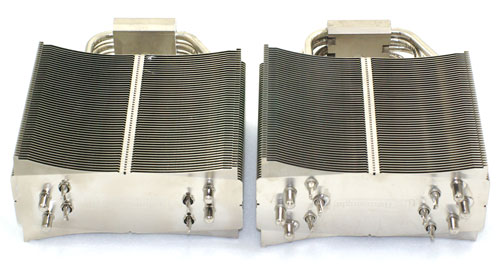
As you can see in the side-by-side comparison with the current Ultra 120, Thermalright has managed to add two more heatpipes to the Ultra 120 Extreme, raising the total heatpipes from four to six. Everything else about the Ultra 120 Extreme seems to be exactly the same as the existing Ultra 120.
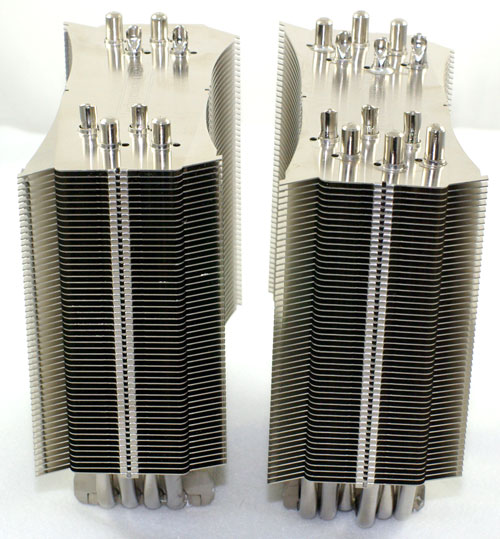
It is always good to see more heatpipes for cooling - particularly in a design that has proven to perform very well as the Ultra 120 has. We wondered, however, exactly how much difference two added heatpipes could make in the performance of the Ultra 120. Was it enough of a difference to justify Thermalright's enthusiasm about the new design?
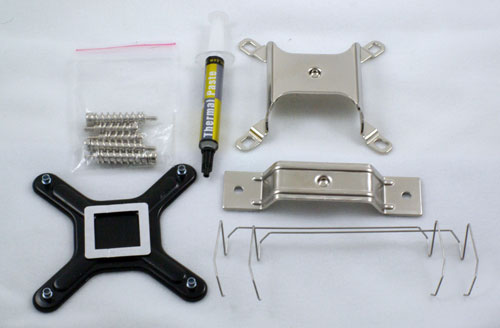
Thermalright also updated the kit with the Ultra 120 Extreme. Where the AM2 adapter is an optional accessory with the Ultra 120 kit, the Socket 775, AM2, and AMD 754/939/940 adapters are all included with the Ultra 120 Extreme.
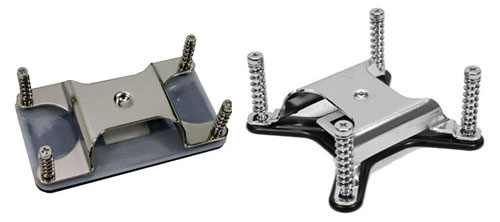
The addition of two extra heatpipes is pretty straightforward. However, the location of the added pipes does create some issues with the Intel socket 775 adapter carried over from the current Ultra 120 kit. The adapter frankly won't fit through the heatpipes in the new design. We actually had to bend the Socket 775 adapter to mount the Ultra 120 Extreme on a Core 2 Duo.
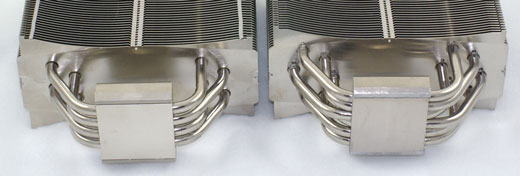
We have alerted Thermalright to the problem, and we sincerely hope they will make modifications to the Socket 775 bracket before shipping the Extreme kits to the retail channel. Those handy with tools will find a way to mount the Ultra 120 Extreme on a Socket 775, but most users will want an adapter that is easier to work with.

To isolate just the impact of the Extreme modification we tested with the same Scythe S-Flex fan used in the Thermalright Ultra 120 review. This excellent fan moves a lot of air, but still keeps noise low with the Sony developed Fluid Dynamic Bearing on the fan motor.
A few days later a package arrived from Taiwan in the stock Thermalright plain brown box. There was not even a new ID on the package for this new cooler, but Thermalright told us it would be called the Thermalright Ultra 120 Extreme. So what is improved on the new Ultra 120 Extreme?

As you can see in the side-by-side comparison with the current Ultra 120, Thermalright has managed to add two more heatpipes to the Ultra 120 Extreme, raising the total heatpipes from four to six. Everything else about the Ultra 120 Extreme seems to be exactly the same as the existing Ultra 120.

It is always good to see more heatpipes for cooling - particularly in a design that has proven to perform very well as the Ultra 120 has. We wondered, however, exactly how much difference two added heatpipes could make in the performance of the Ultra 120. Was it enough of a difference to justify Thermalright's enthusiasm about the new design?

Thermalright also updated the kit with the Ultra 120 Extreme. Where the AM2 adapter is an optional accessory with the Ultra 120 kit, the Socket 775, AM2, and AMD 754/939/940 adapters are all included with the Ultra 120 Extreme.

The addition of two extra heatpipes is pretty straightforward. However, the location of the added pipes does create some issues with the Intel socket 775 adapter carried over from the current Ultra 120 kit. The adapter frankly won't fit through the heatpipes in the new design. We actually had to bend the Socket 775 adapter to mount the Ultra 120 Extreme on a Core 2 Duo.

We have alerted Thermalright to the problem, and we sincerely hope they will make modifications to the Socket 775 bracket before shipping the Extreme kits to the retail channel. Those handy with tools will find a way to mount the Ultra 120 Extreme on a Socket 775, but most users will want an adapter that is easier to work with.

To isolate just the impact of the Extreme modification we tested with the same Scythe S-Flex fan used in the Thermalright Ultra 120 review. This excellent fan moves a lot of air, but still keeps noise low with the Sony developed Fluid Dynamic Bearing on the fan motor.










54 Comments
View All Comments
Clem - Thursday, March 15, 2007 - link
Is the 'Intel Stock HSF for X6800' connected to a:1. Molex 12v outlet (3 pins utilized) fan running at full speed and would you know approximated what that speed that is ?
2. 3 pin Motherboard header - fan running at full speed (approximately what RPM) ?
3. 4 pin Motherboard header - fan running at various speeds ?
I think the 'Intel Stock HSF for X6800' fan can run from 800 RPM to 2600 RPM but somethimes a motherboard will only let it run at 1600 RPM on the 4 pin header.
hox - Thursday, March 8, 2007 - link
Here are my thoughts of the Anadntech Heatsink reviews, while helpful, there is a growing body of end user discrepancies in temperatures realized. This post is to stimulate discussion to determine why end users are not acheiving the same results (degrees C at idle and load) as reported in so many heat sink reviews.I would like to know what you have enabled or disabled in the bios that controls CPU automatic throttling. Typically that would include Enhanced C1 control (C1E), SpeedStep, and for my Asus MB, something called CPU internal thermal control.
These settings affect how the cpu "handles" load and will affect the temps reported to the Ntune program. Programs like CpuZ and Coretemp and Ntune do not detect some of these rapid throttling instances, but the temps of the processor are reduced because of this throttling. The Righmtark CPU temp utility is one of the few programs I know that allows you to visualize this throttling even when you have several of the throttling paramters disabled.
This issue is important because the temps you are seeing, even at idle, are very different for several of your reviewed heatsinks then what end users will experience when they have altered these parameters in the bios.
I believe this will be helpful for end users to feel like the products your reviews are deeming as superior are performing in their hands in a manner similar to your review. Please provide the bios settings to help the end users decide if the equipment they have purchased is functioning properly.
I suspect by doing this, many RMAs and emails to the manufacturer would be reduced.
There is a clear 10C difference between the reported CPU temps at both idle and full load for my QX6700 cpu caused by changing these three settings. Enabling these parameters in the bios I routinely see temps of 33 to 35 C for the cores of my QX6700 at stock speeds, MB temp is 35C. Disabling these parameters, temps on all 4 cores rise to 44C. Thus discrepancy in temps could lead someone to think that the Monsoon II lite cooler I am using is malfunctioning, when in reality it is working properly.
Also it would be helpful if you also tested these devices with the quad core processors which have a higher heat output. By testing the quad core cpus the high end capacity of these heat sinks to move heat would be tested. Providing the thermal resistance Degrees C/Watt would also be a helpful guideling for these devices.
It would also be helpful to comment whether the side door will fit with the thermalright heat sinks. As far as I know this heat sink is taller than the Tuniq which caused end users to move side panel fans and vents.
Thank you
Wesley Fink - Sunday, March 11, 2007 - link
All BIOS settings that affect automatic throttling are turned OFF in our reviews.classy - Thursday, March 8, 2007 - link
But unless you test all of the top solutions with the same fan, there really is no way to determine if one is truly better than the other. While I understand the logic for testing them as is, to not explore apples to apples is clearly short sighted. Now we know that the Extreme 120 is better than the Ultra because they were both tested with same fan. Great job though none the less. Very good quality on these heatsink reviews.chyew - Wednesday, March 7, 2007 - link
I'm quite surprised that the Scythe Ninja is omitted. Wesley, can you be kind enough to add in Scythe Ninja? Thanks!!!!Gary Key - Thursday, March 8, 2007 - link
Wes will have the Ninja B review up after he returns from vacation. It appears in early testing to be a very good solution also.quanta - Wednesday, March 7, 2007 - link
That's just great, the a.s.S-Flex sounds like another potential source where rookit will strike... :)lopri - Wednesday, March 7, 2007 - link
I might have missed this information so if that's the case please someone enlighten me how heavy this HSF is? Considering the heatpipes are made of copper outfit and whatever liquid-ish stuff Thermalright chose to use, the added weight from 2 extra heatpipes wouldn't be trivial, is my guess. The Ultra 120 is already quite heavy and I'd like to know this Extreme version is safe enough for average ATX motherboards.Thanks for this excellent review. My next HSF looks to be definitely this Ultra 120 Extreme.
Gary Key - Wednesday, March 7, 2007 - link
Thermalright has contacted us and the name of the cooler will now be the Thermalright Ultra Extreme. We will update the article shortly. Still no word on a ship date but it should be shortly.PICBoy - Thursday, March 8, 2007 - link
Hi Gary.Just wanted to let you know there are still some traces of the name "PLUS" on the article. I hope this helps:
* Page 1, last paragraph: "To isolate just the impact of the ***Plus*** modification we tested with the same Scythe S-Flex fan used in the Thermalright Ultra 120 review."
* Page 2, Cooling Performance Test Configuration table: "Thermalright Ultra 120 ***Plus***"
* Page 2, last paragraph: "Results with the Ultra 120 Extreme should be even better with the extra cooling provided by the additional heatpipes in the ***PLUS*** design."
* Page 6, fourth paragraph: "We don't know the final selling price for the Thermalright Ultra 120 Extreme, but unless it is a lot more than the Ultra 120 you should definitely opt for the ***Plus*** model."
By the way, can we expect a cooling review for next week also? That's all. Keep up the good work!